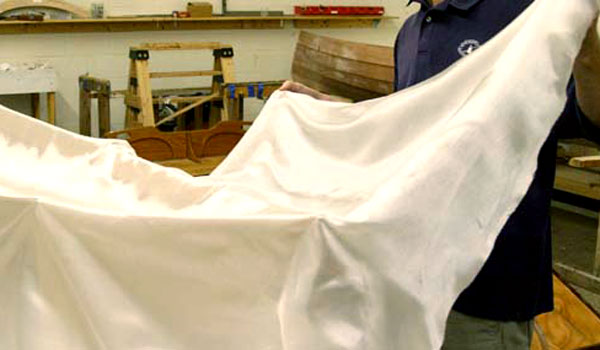
Fiberglassing
Working With Epoxy and Fiberglass
Fiberglass is just what it sounds like: very fine strands of glass, just like the stuff in a window pane, woven into a cloth that vaguely resembles white burlap. Bonded to the hull and deck of a boat with epoxy, it will provide a tough skin that will help minimize damage from impacts (that rock you didn't see) or abrasion (dragging the boat up on a rocky beach).
I also like how a sheath of fiberglass over the entire hull and deck improves the durability and gloss of the finish, whether you use varnish or paint. Indeed, if you use low-viscosity epoxy, the fiberglass will be invisible beneath varnish.

How to fiberglass a hull - We use 6- and 4-ounce cloth on our boats. 4-ounce is lighter but more difficult to apply because it wrinkles so easily.
Smooth up the hull with 80 and 120 grit sandpaper, taking care to round over the chines and keel to about a 3/8-inch radius; fiberglass won't smoothly turn a sharp corner. With your boat upside down on sawhorses, drape the dry hull with cloth. Roughly trim the cloth to the sheerline, leaving maybe an extra inch all around. Gently smooth the wrinkles out, working from the middle of the boat towards the ends. You'll be surprised how easily the cloth conforms to the shape of the hull, even the stem and stern, without cutting darts or seams in the cloth. In all likelihood, the only place you'll need to cut a dart is at the extreme stern.

Mix about a pint of unthickened epoxy, walk purposefully to the boat, and dump a big pool right in the middle of the bottom panels. Using a plastic squeegee or a foam roller, quickly spread the expanding pool along the bottom panels. Spread the epoxy into the cloth on the sides of the boat by letting the goo run over the chine onto the sides. Repeat the process until the fiberglass has become completely clear everywhere, switching to a disposable brush to wet out the ends of the boat where the epoxy tries to run onto the floor. You shouldn't have any runs; the cloth should be entirely clear, but the weave should still show prominently. Don't apply too much resin; it will "float" the cloth, decreasing strength and increasing lumps.
Second and third coats - When the first coat has tacked up or cured, you will now fill the weave with additional coats of epoxy. Sometimes I can manage to fill the weave with just a second coat, but this time the weave of the cloth will not be soaking up resin, and an overly thick coat will run and make a big mess on the floor. Many thin coats are always preferable, and count on at least three. Ideally, when enough epoxy has been applied, the hull is smooth and glossy without the weave of the cloth showing anywhere. Take a look at our Shop Tip When Have I Filled the Fiberglass Weave with Epoxy?

Fiberglassing the deck - The deck is 'glassed prior to the installation of the cockpit coaming. Carefully round-over the hull-to-deck joint; a 3/8" radius or more is ideal. Drape 4oz cloth over the deck as with the hull. It's economical to divide a shorter rectangle of fabric into two narrow triangles with a seam at the cockpit. The cloth should overlap the sides of the hull about 1.5 to 2". The 4oz takes less epoxy to wet out. Be careful not to let the epoxy run down the sides in big, hard-to-sand rivulets.

When you've filled the weave of the deck 'glass, sand it smooth with 120, then 220 grit. The overlap on the sides of the hull is "feathered in" with the sander.
What if I want to varnish my hull? - No need to worry. 4- or 6-ounce fiberglass cloth will be almost perfectly clear and will look fine beneath coats of varnish. Some precautions, though: you'll want to be sure you have the fiberglass cloth completely filled with epoxy, even if it means extra coats. If you sand into the fabric anywhere, that area may show up under the varnish as a foggy spot in the finish. Also give serious thought to the use of a low-viscosity epoxy like MAS Epoxies. Thicker epoxies make it difficult to wet out fiberglass, and the excessive kneading of the clear epoxy will inject zillions of microscopic air bubbles into the epoxy, creating cloudy or milky spots all over your hull that are impossible to get rid of.